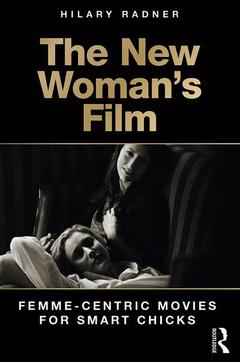The New Woman's Film Femme-centric Movies for Smart Chicks
Auteur : Radner Hilary

With the chick flick arguably in decline, film scholars may well ask: what has become of the woman?s film? Little attention has been paid to the proliferation of films, often from the independent sector, that do not sit comfortably in either the category of popular culture or that of high art??films that are perhaps the corollary of the middle-brow novel, or "smart-chick flicks". This book seeks to fill this void by focusing on the steady stream of films about and for women that emerge out of independent American and European cinema, and that are designed to address an international female audience. The new woman's film as a genre includesnarratives with strong ties to the woman?s film of classical Hollywood while constituting a new distinctive cycle of female-centered films that in many ways continue the project of second-wave feminism, albeit in a modified form.
Topics addressed include: The Bridges of Madison County (Clint Eastwood, 1995); the feature-length films ofNicole Holofcener, 1996-2013; the film roles of Tilda Swinton; Rachel Getting Married (Jonathan Demme, 2008); Blue Jasmine (Woody Allen, 2013); Frances Ha (Noah Baumbach, 2012), Belle (Amma Asante, 2013), Fifty Shades of Grey (Sam Taylor-Johnson, 2015) and Jane Campion?s Top of the Lake (Sundance Channel, 2013-).
Introduction: What Do Women Watch?
Chapter One: After the Woman’s Picture: The New Woman’s Film and the Chick Flick
Chapter Two: The New Woman’s Film in the Twenty-first Century: The Smart-Chick Film and Rachel Getting Married (Jonathan Demme, 2008)
Chapter Three: Anticipating the Twenty-first Century: "Dirty Harry Bathed in a Romantic Glow?" and The Bridges of Madison Country (Clint Eastwood, 1995)
Chapter Four: Nicole Holofcener as the American Female Auteur: "Keeping It Real"–– Walking and Talking (1996), Lovely & Amazing (2002), Friends with Money (2006) Please Give (2010), Enough Said (2013)
Chapter Five: Stardom, Celebrity and the New Woman’s Film: Tilda Swinton and the Maternal Melodrama ––"Winning an Oscar Was Wasted on Me"
Chapter Six: Oscars for Women and the Films of Woody Allen: Blue Jasmine (Woody Allen, 2013)
Chapter Seven: The Girl Crush: Frances Ha (Noah Baumbach, 2013), "The Toast of Telluride"
Chapter Eight: Diversity, the Female Biopic and the New Woman’s Film: Belle (Amma Asante, 2013)
Chapter Nine: A Past with a Future, the Ongoing Evolution of the New Woman’s Film: From Top of the Lake (Sundance Channel, 2013-) to Fifty Shades of Grey (Sam Taylor-Johnson, 2015)
Coda: Feminism Redux
Hilary Radner is Professor of Film and Media Studies in the Department of History and Art History at the University of Otago. Her research interests revolve around understanding the representations of gender and identity in contemporary visual culture, particularly in terms of how these evolve over time in relation to second-wave feminism. She is the author of two monographs Shopping Around: Consumer Culture and the Pursuit of Pleasure (1995), and Neo-Feminist Cinema: Girly Films, Chick Flicks and Consumer Culture (2011). Her co-edited volumes include, Film Theory Goes to the Movies (1993), Feminism at the Movies: Understanding Gender in Contemporary Cinema (2011), and A Companion to Contemporary French Cinema (2015).
Date de parution : 02-2017
15.2x22.9 cm
Disponible chez l'éditeur (délai d'approvisionnement : 14 jours).
Prix indicatif 53,83 €
Ajouter au panierDate de parution : 02-2017
15.2x22.9 cm
Thème de The New Woman's Film :
Mots-clés :
Woman’s Film; gender and media; Nicole Holofcener; Clint Eastwood; Chick Flick; Romantic comedy; Conglomerate Hollywood; Tilda Swinton; Blue Jasmine; Cate Blanchett; Girly Film; Woody Allen; Woman’s Picture; Independent Woman; feminist film studies; Madison County; cinema studies; Classical Hollywood; Hollywood; Feminist Film Scholars; Jane Campion; Auteur Director; Frances Ha; Catherine Keener; Rachel Getting Married; Film’s Conclusion; female directors; Independent Woman’s Film; women's films; Smart Film; chick flicks; Male Weepie; Maternal Melodramas; DVD Sale; Package Unit System; Sundance Channel; Kristen Wiig; Female Stars; Gina Prince Bythewood; Rebecca Miller



